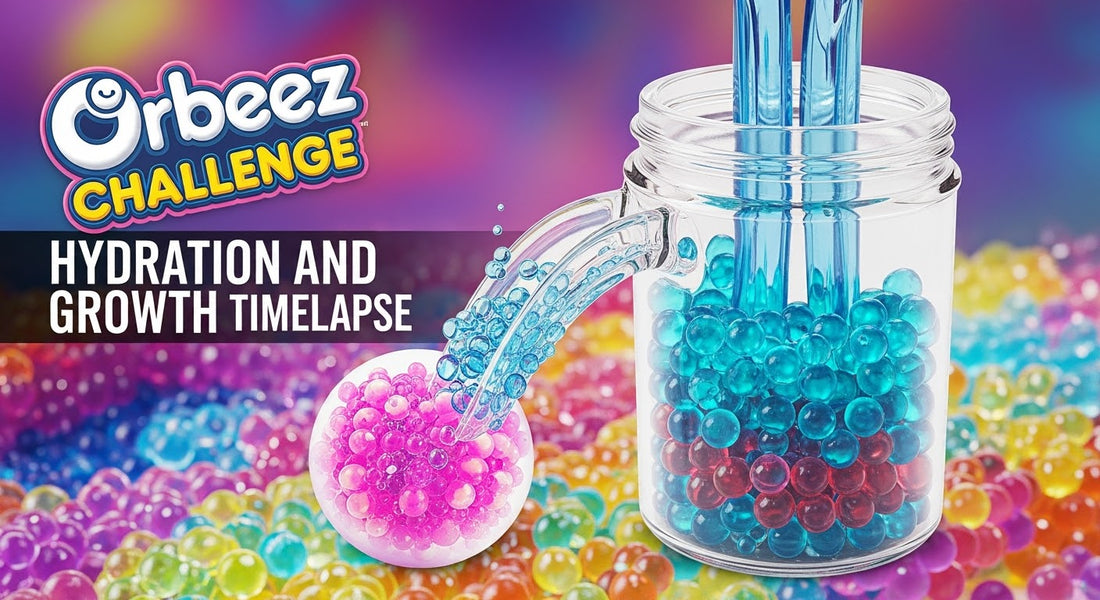
How to Dispose of Orbeez Without Harming the Environment
Share
Orbeez—those vibrant, squishy water beads that bring joy to sensory play and creative decor—have a hidden downside: improper disposal can harm ecosystems, clog infrastructure, and contribute to waste. Made of superabsorbent polymer (SAP), these beads can absorb up to 300 times their weight in water, making them tricky to discard responsibly. But here’s the good news: you don’t have to choose between enjoying Orbeez and protecting the planet. This guide will walk you through eco-friendly ways to dispose of Orbeez, plus zero-waste repurposing hacks to keep them out of landfills entirely.
Why Orbeez Pose Environmental Risks (And What to Avoid)
Before diving into solutions, it’s critical to understand why standard disposal methods fall short for the environment. SAP, while non-toxic, is designed to resist breakdown—a trait that makes Orbeez fun but problematic when discarded incorrectly. Here are the biggest environmental hazards to avoid:
-
Waterway Contamination: Flushing Orbeez or pouring them down drains sends them into sewage systems. If they slip through treatment plants (which they often do, thanks to their small size when dry), they end up in rivers, lakes, or oceans. Marine life may mistake them for food, leading to ingestion and blockages in their digestive systems.
-
Landfill Buildup: Wet Orbeez in landfills trap moisture, creating ideal conditions for mold growth and methane emissions— a potent greenhouse gas. Even dry Orbeez can take years to biodegrade, occupying space in already overflowing waste facilities.
-
Soil Disruption: Dumping wet Orbeez in gardens or yards disrupts soil structure. They compete with plants for water, create air pockets that suffocate roots, and can attract pests like rodents or insects drawn to the moist beads.
5 Eco-Friendly Ways to Dispose of Orbeez
The best disposal methods prioritize reducing waste, reusing materials, and minimizing environmental impact. Below are tried-and-tested strategies that keep Orbeez out of ecosystems and landfills.
1. Dry, Crush, and Compost (For Slow but Natural Breakdown)
Composting is one of the most sustainable ways to dispose of Orbeez—if done correctly. SAP biodegrades over time in active compost piles, where heat, moisture, and microorganisms break down the polymer. Here’s how to do it right:
-
Thoroughly Dry the Beads: Spread wet Orbeez on a baking sheet or cardboard in a single layer. Place them in a well-ventilated area (like a porch or sunny windowsill) for 2–3 days until they shrink back to hard, tiny beads. This step is non-negotiable—wet Orbeez will mold in compost.
-
Crush for Faster Breakdown: Use a mortar and pestle or rolling pin to crush the dried beads into smaller pieces. This increases their surface area, helping microorganisms decompose them faster.
-
Mix Sparingly into Compost: Add ½–1 cup of crushed Orbeez per cubic foot of compost. Mix them with nitrogen-rich materials (like fruit peels or grass clippings) and carbon-rich materials (like leaves or cardboard) to balance the pile. Avoid adding large clumps—they’ll take months to break down.
Note: This works best in hot, active compost piles. If your compost is cold or slow, skip this method and opt for repurposing instead.
2. Repurpose as Water-Retentive Soil Additive
Instead of discarding Orbeez, turn them into a beneficial garden tool. Dried Orbeez act as natural water reservoirs, helping plants retain moisture during dry spells—perfect for eco-conscious gardeners. Here’s how to use them:
-
Prepare the Beads: Dry and crush the Orbeez as in Method 1. For potted plants, keep them slightly larger; for garden beds, crush them finer.
-
Mix with Soil: For potted plants, add 1 part crushed Orbeez to 4 parts potting soil. For garden beds, till the beads into the top 6 inches of soil. As you water, the beads absorb moisture and release it slowly, reducing the need for frequent watering (and saving water!).
-
Choose the Right Plants: This works wonders for moisture-loving plants like tomatoes, basil, pothos, and ferns. Avoid succulents or cacti—they prefer dry soil, and Orbeez may cause root rot.
Bonus: Colored Orbeez add a subtle pop of color to planters, blending functionality with decor.
3. Donate to Educational or Community Groups
One person’s “trash” is another’s teaching tool. Schools, preschools, occupational therapy clinics, and community centers often use Orbeez for sensory learning, science experiments, and art projects. Donating clean Orbeez keeps them out of landfills and supports education. Here’s how to donate:
-
Inspect for Cleanliness: Ensure the Orbeez are free of dirt, mold, or debris. If they’re hydrated, drain the water and dry them completely.
-
Reach Out to Local Organizations: Call or email nearby schools, daycares, or therapy centers. Ask if they accept Orbeez donations—many are thrilled to receive free sensory materials.
-
Package Properly: Store dried Orbeez in a labeled, airtight container (like a mason jar or plastic tub) to prevent moisture absorption during transport. Include a note with care instructions (e.g., “Hydrate with water to expand”).
This method creates a circular economy for Orbeez, turning waste into wonder for kids and learners.
4. Upcycle into DIY Home Decor
Orbeez’s vibrant colors and texture make them perfect for zero-waste crafts. Upcycling them into decor keeps them out of landfills while adding personality to your home. Try these ideas:
-
Glow-in-the-Dark Centerpieces: Hydrate Orbeez with water, then place them in clear glass jars with fairy lights. Seal the jars and use them as table centerpieces for parties or nightlights in kids’ rooms.
-
Resin Art Accents: Mix dried Orbeez into epoxy resin to create coasters, tray liners, or wall art. The beads add dimension and color, making each piece one-of-a-kind.
-
Holiday Ornaments: Fill clear plastic ornament bulbs with dried Orbeez, glitter, or small figurines. Hang them on Christmas trees or use them as party favors.
Upcycling not only reduces waste but also lets you flex your creative muscles—no artistic experience required!
5. Dispose via Specialized Waste Programs
If you have a large quantity of Orbeez (e.g., from a party or broken sensory bin) that can’t be reused or composted, check for local waste programs that accept superabsorbent polymers. Many cities offer “hard-to-recycle” or “special waste” collection days for materials that don’t fit in regular bins. Here’s what to do:
-
Check Local Guidelines: Visit your city’s waste management website or call their hotline. Search for terms like “superabsorbent polymer disposal” or “non-recyclable plastic waste.”
-
Prepare for Drop-Off: Dry the Orbeez completely, then bag them in a clear plastic bag labeled “Orbeez—superabsorbent polymer.” Some facilities may require them to be separated from other waste.
-
Avoid Hazardous Waste Bins: Orbeez are non-toxic, so they don’t belong in hazardous waste. Stick to special waste or general waste bins if no other option exists.
Zero-Waste Tips to Reduce Orbeez Waste in the First Place
The most eco-friendly way to dispose of Orbeez is to avoid excess waste altogether. These tips will help you minimize your Orbeez footprint:
-
Hydrate Only What You Need: Orbeez expand exponentially—start with 1 teaspoon of dry beads for small projects, 2–3 teaspoons for sensory bins. You can always hydrate more later, but you can’t undo over-hydration.
-
Store Unused Orbeez Properly: Keep hydrated Orbeez in an airtight container with water in the fridge. They’ll stay fresh for up to 2 weeks. Drain and dry them when you’re done, then store in a cool, dry place for future use.
-
Choose Reusable Alternatives: For sensory play, swap Orbeez for natural materials like rice, beans, or dried corn. These are biodegradable and can be composted directly after use.
Conclusion
Disposing of Orbeez without harming the environment is all about intentionality. By choosing to dry and compost, repurpose, donate, or upcycle, you turn a potential waste problem into an opportunity to support sustainability. Avoiding harmful methods like flushing or dumping ensures Orbeez don’t end up in waterways or landfills, protecting wildlife and ecosystems. Remember: every small choice counts. Whether you’re a parent, gardener, or crafter, these eco-friendly methods let you enjoy Orbeez while keeping the planet in mind. Next time you’re ready to say goodbye to your Orbeez, reach for one of these strategies—your environment will thank you.
